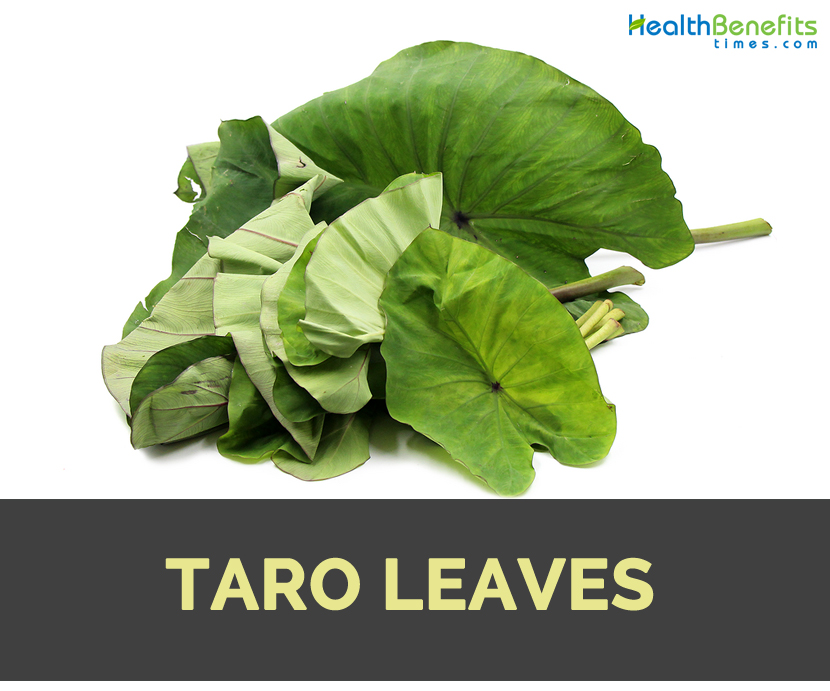Leaves are cooked before consumption and are boiled, sautéed, fried and steamed. Taro leaves are a vital ingredient in Hawaiian dish known as lau lau consisting of wrapping chicken, salted butterfish and pork in the leaves and steamed in underground oven.
Health Benefits of Taro leaves
- Digestive health
Cooked leaves are easily digestible. With high content of dietary fiber, it is helpful to maintain digestive system. Fiber adds bulk to the stools and normalizes bowel movements. It also prevents digestive problems such as constipation and irritable bowel syndrome. Besides this, fiber lowers the chances of colon cancer.
- Vision health
Taro leaves have ample amounts of Vitamin A essential for the bodily functions even eyes. It enhance eye health, maintains vision acuity and prevent various eye disorders such as blindness, myopia and cataract.
- Prevent cancer
Regular intake of cooked taro helps to ward off diseases such as cancer. It is due to the presence of Vitamin C, a powerful antioxidant that prevents common ailments such as cough, cold and cancers. This vitamin is needed for the growth of connective tissues such as tendons, ligaments and cartilage. It enhances overall immunity level of the body; assist in synthesis of neurotransmitters, hormones and speeds up the healing process.
- Maintain cholesterol balance
Taro leaves have 0% cholesterol and total fat contributes 1%. People experiencing high cholesterol levels may find it beneficial in lowering cholesterol naturally. Moreover, it has dietary fiber and methionine that helps to lower cholesterol efficiently by breaking down triglycerides. The diet based on taro leaves is the best way to remain healthy.
- Healthy heart
Taro leaves has low saturated fat making it a heart healthy food. Fiber halts accretion of cholesterol and fat in bloodstreams and potassium helps to maintain normal blood pressure. It reduces the levels of homocysteine in blood and prevents the heart ailments and stroke. Also it maintains blood pressure under control. It lowers homocysteine levels within blood for preventing strokes and heart problems.
- Fetus health
Folate is a crucial vitamin for women at the time of pregnancy. Taro leaves are packed with this vitamin. Folate is required for healthy development of fetus. It prevents birth imperfections such as neural tube defects. Besides this, folate is imperative for DNA synthesis and helps to prevent rectal cancer and colon cancer.
- Protect cells
Taro leaves has ample amounts of carotenoid and phenolic compounds shown to exhibit antioxidant properties. These chemical compounds assist body to combat free radicals and prevent further damage as well as oxidative stress.
- Prevention of anemia
The minerals such as iron have a role in formation of RBCs and transports oxygen to various parts of the body. Anemic patients should consume taro on regular basis to meet iron requirement. This also avoids weakness, fatigue and tiredness.
- Lowers wrinkle appearance
Taro has high content of amino acid known as threonine which supports formation of collagen and elastin which are crucial for healthy skin. Regular intake of vegetable lowers the signs of aging such as wrinkles and also rejuvenates skin.
- Electrolyte balance
Potassium is a crucial mineral for proper functioning of the body. It absorbs and break down carbohydrates, constructs muscles, maintain acid-base balance and also promote the normal development of the body. Furthermore, potassium is crucial to sustain the body’s fluid as well as electrolyte balance. Taro leaves have high content of potassium so its daily intake offers sufficient amounts of potassium.
Culinary uses
- Spread with spiced chickpea paste, sliced, rolled, steamed and deep fried. Then simmer it in red chili, coconut, coriander, tamarind and garlic.
- Use it as an accompaniment to curries and dishes which contains coconut milk.
- It pairs well with ginger, garlic, onion and meats such as chicken, fish, beef, pork, coconut milk, dried shrimp, chickpeas, sweet potato and tomatoes.
How to Make Taro Leaves?
Step 1: Boil water in a pot.
Step 2: Add the leaves (desired amount) to the boiling water.
Step 3: Let the leaves boil for about 10-15 minutes.
Step 4: Drain the leaves completely.
Step 5: Then add it to a recipe.
Side Effects
- The leaves could be harmful when not properly cooked.
- Leaves coming in contact with skin cause topical inflammation.
- Leaves in contact with wounds causes itchiness, irritation and redness.
- Avoid raw consumption due to its toxicity.
- The presence of calcium oxalate source can cause swelling and itchiness to the throat.
- Soak the leaves overnight and cook it properly to avoid toxicity.
References:
https://www.organicfacts.net/taro-leaves.html
https://www.specialtyproduce.com/produce/Taro_Leaves_3409.php
https://www.thecoconet.tv/coco-talanoa/health-well-being/health-benefits-of-taro-leaves/
Comments
| Taro Leaves Quick Facts | |
|---|---|
| Name: | Taro Leaves |
| Origin | Southern India and Southeast Asia |
| Colors | Dark green |
| Shapes | Triangular-ovate, sub-rounded and mucronate |
| Major nutrients | Vitamin C (57.22%) Vitamin A (43.86%) Vitamin B2 (42.38%) Manganese (23.39%) Copper (22.56%) |
| Name | Taro Leaves |
|---|---|
| Native | Southern India and Southeast Asia |
| Leaf size | 40 cm × 24.8 cm (15.7 in × 9.8 in) |
| Leaf shape | Triangular-ovate, sub-rounded and mucronate |
| Leaf color | Dark green |
| Major Nutritions | Vitamin C (Ascorbic acid) 51.5 mg (57.22%) Vitamin A, RAE 307 µg (43.86%) Vitamin B2 (Riboflavin) 0.551 mg (42.38%) Manganese, Mn 0.538 mg (23.39%) Copper, Cu 0.203 mg (22.56%) Iron, Fe 1.71 mg (21.38%) Vitamin B9 (Folate) 70 µg (17.50%) Vitamin B1 (Thiamin) 0.202 mg (16.83%) Potassium, K 667 mg (14.19%) Calcium, Ca 125 mg (12.50%) |
| Calories in 1 cup (145 g) | 35 Kcal. |



